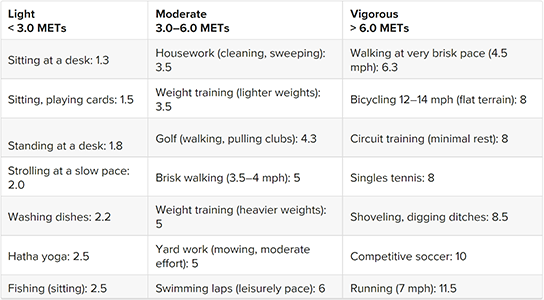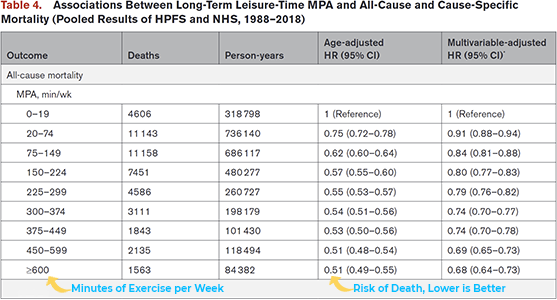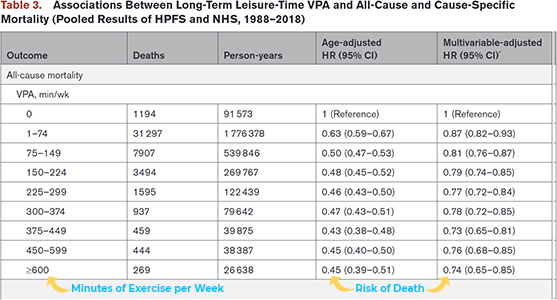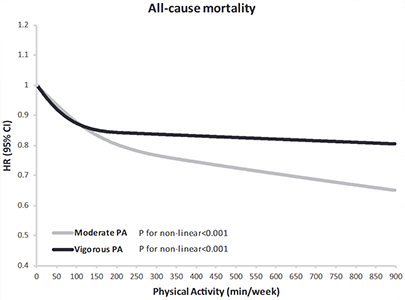A massive new study on longevity has flipped my thoughts on exercise. This is big news. When the physical activity guidelines were released in 2008, they stated substantial health benefits can be achieved with 150 minutes of exercise per week [1]. In 2018, they doubled the guideline to 300 minutes [2]. And now this latest study says that’s still not enough [3]. What amount of exercise is optimal? How have my thoughts shifted? And are you even close to the new recommendation? Well, let’s get into it!
Physical Activity Intensity
Just over a week ago, an exceptional new study was published in the journal Circulation. The study featured 116,221 adult participants followed for over 30 years. It’s a substantial sample size, over a long duration, with hard end points. The kind of study I like. They looked at the impacts of moderate and vigorous physical activity. How many minutes of each resulted in the lowest risk of death?

First, some quick definitions. Moderate physical activity was defined as less than 6 metabolic equivalents (METs). This includes activities like walking, weightlifting, or calisthenics. Vigorous physical activity was defined as greater than 6 METs. This includes activities like jogging, swimming, bicycling, or playing tennis. And this information was collected from participants every two years. [3]
Optimal Level of Physical Activity
How many minutes per week of moderate activity exercise do you think is optimal? It certainly isn’t zero. The 150-minute recommendation in 2008 is good. The 300-minute recommendation in 2018 is better. But 600 minutes is best! That’s 85 minutes per day of walking or weightlifting. That’s a lot.

But is the same true for vigorous activity? Previous guidelines suggested 75 minutes but let’s try 4 times that! Up to 300 minutes of vigorous activity, or 43 minutes a day, was shown to be optimal for reducing risk of death. That’s a lot of running and tennis. Exercise beyond that amount didn’t show further benefits or harm as results tended to level off in the higher range.

Study Takeaways
Now there are a few important takeaways here. First, the study suggests that the maximum association with lower mortality can be achieved by performing ≈150 to 300 min/wk of vigorous activity, 300 to 600 min/wk of moderate activity, or an equivalent combination. You don’t need to both. Either will work but to me it makes the most since to do a combination. I talked about this in my post about training zones. Training at different intensities taxes different energy systems. It’s worth training each of these energy systems effectively for maximum health benefits in endurance, speed, and power.

Second, too much exercise doesn’t appear to be a thing. If you’re progressing slowly to avoid injury, exhaustion, or breakdown, the more the better in terms of mortality. No harmful association was shown among individuals who reported >4 times the recommended minimum levels of moderate and vigorous physical activity. Don’t be worried about exercising too much.
And third, this news is exciting! I understand you can look at this study and be demoralized by the volume of exercise needed for the best results. It’s a lot of time required. But I look at it and am thrilled. If exercising 10 hours a week is optimal, just think about what you can accomplish with that input. 10 hours a week of weightlifting and you’re an animal. 10 hours of tennis and you’re semi-pro. 10 hours of running and you’re doing marathons in under 3 hours. A substantial input can yield a substantial output. That’s exciting.
My Exercise Routine
I decided to add up my physical activity minutes. I knew my vigorous minutes would be high with my running routine and rowing cross-training. I wasn’t wrong. 325 minutes per week of vigorous activity. With that alone, I’m hitting the optimal recommendations. Next, I calculated moderate activity with my lifting sessions and occasional hikes. 345 minutes. That too was decent. Plus, I average around 560 minutes of light activity on my treadmill desk across four workdays. Pretty good.

If you’re wondering how I can exercise 10 hours a week without becoming an animal, or a 3-hour marathoner… I share the same thoughts. Give me some time. In the past, my consistency hasn’t always been there, partly due to injuries. And I haven’t always focused on progressive overload. Just putting in the minutes is enough to prevent death, but not increasing the weights or run pace effectively isn’t enough to become lethal. But I’m getting there. My habits are being built and the foundation is being poured.
And if you’re looking for a simple approach to get your physical activity in, this is my suggestion. Perform a 45-minute Zone 2 biking session with a few intervals at the end, four times a week. Throw in a few total body strength sessions and you’re on your way to living forever too.
Final Thoughts
You can increase lifespan and healthspan by optimizing sleep, nutrition, and exercise. These are important tools to live longer without chronic disease. But exercise has a magical trick up its sleeve. Performance. What’s a better way to build and maintain strength, speed, and agility? How can you best age while maintaining robust muscle and dense bones? Exercise is that elixir of performance. And as shown from this recent journal publication, it’s that elixir of life too. Certainly, sleep and nutrition are equally important in aiding that process. So, how many minutes a week do you exercise? How can you get in your 10 hours? What are you going to accomplish with that level of dedication? It’s exciting.

Hi, I’m Brandon Zerbe
Welcome to myHealthSciences! Every week I share habits for health excellence. I do this by covering topics like Fitness, Nutrition, Sleep, Cognition, Finance and Minimalism. You can learn more about me here.
Sources:
- [1] 2008 Physical Activity Guidelines
- [2] 2018 Physical Activity Guidelines
- [3] Long-Term Leisure-Time Physical Activity Intensity and All-Cause and Cause-Specific Mortality: A Prospective Cohort of US Adults
- [4] What Exactly Are METs, and What Should You Know About Them?
